Notification and consent: the differential effects of parental involvement laws on teen abortion

US state legislation requiring parental involvement in the abortion decision of a minor has grown in prevalence since its origin in the 1970s. Today, 36 states impose a parental involvement requirement on their residents below the age of 18. These laws come in two primary categories: parental notification and parental consent. Though much research estimates the effects of these policies, limited evidence exists regarding any differential impact between parental notification and parental consent. This paper uses the synthetic control method to determine if the increased marginal cost of an abortion imposed by a parental consent statute affects the abortion rate and birth rate for minors relative to parental notification. Results indicate no evidence of a marginal effect of parental consent laws on the abortion/birth rate for minors overall, suggesting that the additional cost of a parental consent law may be small.
This is a preview of subscription content, log in via an institution to check access.
Access this article
Subscribe and save
Springer+ Basic
€32.70 /Month
- Get 10 units per month
- Download Article/Chapter or eBook
- 1 Unit = 1 Article or 1 Chapter
- Cancel anytime
Buy Now
Price includes VAT (France)
Instant access to the full article PDF.
Rent this article via DeepDyve
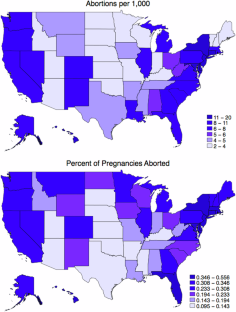
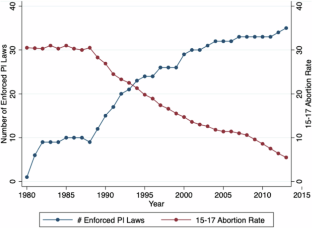
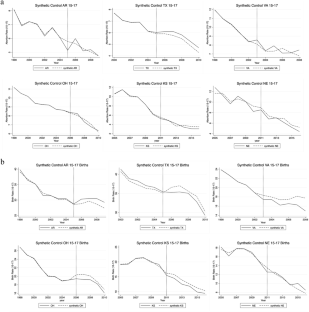
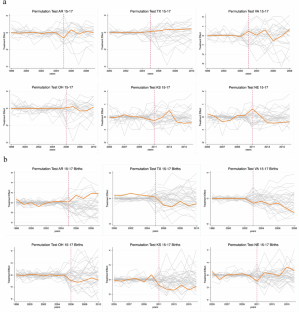
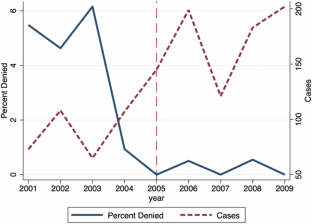
Similar content being viewed by others

The Impact of Parental Involvement Laws on the Abortion Rate of Minors
Article 06 February 2020

Chapter © 2019

Surrogacy and Adoption: An Empirical Investigation of Public Moral Attitudes
Article Open access 29 March 2024
Explore related subjects
Notes
Self-managed abortion refers to efforts by an individual to end a pregnancy on their own outside of the formal healthcare system.
With the exception of the state of Georgia, all states who provide ITOP reports indicate abortion counts consistent with the CDC reports. Georgia consistently reports lower abortion counts in their ITOP data. In the analysis, I choose to use 15–17 abortion rates from the Georgia ITOP system. Results, available upon request, show that the results of the analysis are robust to the exclusion of Georgia from the donor pool.
RMSPE = root mean-square prediction error.
Following the method described by Dube and Zipperer, I also use the Weibull-Grumbel rule: \(_=\frac_>\) , where \(_\) describes the rank of the treatment effect, and \(N\) is the number of control states.
AFAB = assigned female at birth.
References
- Abadie, A., Diamond, A., & Hainmueller, J. (2010). Synthetic Control Methods for Comparative Case Studies: Estimating the Effect of California’s Tobacco Control Program. Journal of the American Statistical Association, 105, 493–505. ArticleGoogle Scholar
- Arkansas Department of Health Statistics. (2000–2016) Induced Abortions. https://healthy.arkansas.gov/stats/inducedabortion2000=index:htm.
- Arroyo, C. R., & Zhang, J. (1997). Dynamic Microeconomics Models of Fertility Choice: A Survey. Journal of Population Economics, 10, 23–65. ArticleGoogle Scholar
- Cartoof, V. G., & Klerman, L. (1986). Parental Consent for Abortion; Impact of the Massachusetts Law. American Journal of Public Health, 76, 397–400. ArticleGoogle Scholar
- Clark, E. A., Cordes, S., Lanthrop, E., & Haddad, L. B. (2021). Abortion Restrictions in the State of Georgia: Anticipated Impact on People Seeking Abortion. Contraception, 103, 121–126. ArticleGoogle Scholar
- Colman, S., Joyce, T., & Kaestner, R. (2008). Misclassification Bias and the Estimated Effect of Parenatl Involvement Laws on Adolescents’ Reproductive Outcomes. American Journal of Public Health, 98, 1881–1885. ArticleGoogle Scholar
- Dube, A., & Zipperer, B. (2015). Pooling Multiple Case Studies Using Synthetic Controls: An Application to Minimum Wage Policies.
- Elam-Evans, L. D., Strauss, L. T., & Herndon, J., et al. (2002). Abortion Surveillance - United States, 1999. MMWR Surveillance Summ, 51(SS09), 1–28. Google Scholar
- Elam-Evans, L. D., Strauss, L. T., & Herndon, J., et al. (2003). Abortion Surveillance - United States 2000. MMWR Surveillance Summ, 52(SS12), 1–32. Google Scholar
- Ellertson, C. (1997). Mandatory Parental Involvement in Minor’s Abortions: Effects of the Laws in Minnesota, Missouri, and Indiana. American Journal of Public Health, 87, 1367–1374. ArticleGoogle Scholar
- Ferman, B., Pinto, C., & Possebom, V. (2020). Cherry Picking with Synthetic Controls. Journal of Policy Analysis and Management, 39, 510–532. ArticleGoogle Scholar
- Gamble, S. B., Strauss, L. T., & Parker, W. Y., et al. (2008). Abortion Surveillance - United States 2005. MMWR Surveillance Summ, 57(SS13), 1–32. Google Scholar
- Georgia Department of Public Health Online Analytical Statistical Information System. (1995-2016). Induced Termination of Pregnancy. https://oasis.state.ga.us/oasis/webquery/qryITOP.aspx.
- Haas-Wilson, D. (1996). The Impact of State Abortion Restrictions on Minors’ Demand for Abortions. Journal of Human Resources, 31, 140–158. ArticleGoogle Scholar
- Herndon, J., Strauss, L. T., & Whitehead, S., et al. (2002). Abortion Surveillance - United States, 1998. MMWR Surveillance Summ, 51(SS03), 1–32. Google Scholar
- Iowa Department of Health. (2005-2016). Vital Statistics: Termination of Pregnancy Data. https://idph.iowa.gov/health-statistics/data.
- Jatlaoui, T. C., Boutot, M. E., & Mandel, M. G., et al. (2018). Abortion Surveillance - United States 2015. MMWR Surveillance Summ, 67(SS13), 1–45. Google Scholar
- Jatlaoui, T. C., Eckhaus, L., & Mandel, M. G., et al. (2019). Abortion Surveillance - United States 2016. MMWR Surveillance Summ, 68(SS11), 1–41. Google Scholar
- Jatlaoui, T. C., Ewing, A., & Mandel, M. G., et al. (2016). Abortion Surveillance - United States 2013. MMWR Surveillance Summ, 65(SS12), 1–44. Google Scholar
- Jatlaoui, T. C., Shah, J., & Mandel, M. G., et al. (2017). Abortion Surveillance - United States 2014. MMWR Surveillance Summ, 66(SS25), 1–48. Google Scholar
- Jones, K. M., & Pineda-Torres, M. (2024). TRAP’d Teens: Impacts of abortion provider regulations on fertility and education. Journal of Public Economics, 234, 105112.
- Joyce, T. (2010). Parental Consent for Abortion and the Judicial Bypass Option in Arkansas: Effects and Correlates. Perspectives on Sexual and Reproductive Health, 42, 168–175. ArticleGoogle Scholar
- Joyce, T., & Kaestner, R. (1996). State Reproductive Policies and Adolescent Pregnancy Resolution: The Case of Parental Involvement Laws. Journal of Health Economics, 15, 579–607. ArticleGoogle Scholar
- Joyce, T., Kaestner, R., & Colman, S. (2006). Changes in Abortion and Births and the Texas Parental Notification Law. New England Journal of Medicine, 354, 1031–1038. ArticleGoogle Scholar
- Joyce, T. J., Kaestner, R., & Ward, J. (2020). The Impact of Parental Involvement Laws on the Abortion Rate of Minors. Demography, 57, 323–346. ArticleGoogle Scholar
- Kane, T. J., & Staiger, D. (1996). Teen Motherhood and Abortion Access. The Quarterly Journal of Economics, 111, 467–506. ArticleGoogle Scholar
- Klößner, S., & Pfeifer, G. (2018). Outside the Box: Using Syntheticc Control Methods as a Forecasting Technique. Applied Economics Letters, 25, 615–618. ArticleGoogle Scholar
- Koonin, L. M., & Smith, J. C. (1998). Strauss MRLT Abortion Surveillance - United States, 1995. MMWR Surveillance Summ, 47(SS-2), 31–68. Google Scholar
- Koonin, L. M., Strauss, L. T., & Chrisman, C. E., et al. (1999). Abortion Surveillance - United States, 1996. MMWR Surveillance Summ, 48(SS04), 1–42. Google Scholar
- Koonin, L. M., Strauss, L. T., & Chrisman, C. E., et al. (2000). Abortion Surveillance - United States, 1997. MMWR Surveillance Summ, 49(SS11), 1–44. Google Scholar
- Kost, K., Maddow-Zimet, I., & Arpaia, A. (2017). Pregnancies, Births, and Abortions Among Adolescents and Young Women in the United States, 2013: National and State Trends by Age, Race, and Ethnicity. The Guttmacher Institute.
- Levine, P. B. (2003). Parental Involvement Laws and Fertility Behavior. Journal of Health Economics, 22, 861–878. ArticleGoogle Scholar
- MacAfee, L., Castle, J., & Theiler, R. N. (2015). Association Between the new Hampshire Parental Notification Law and Minors Undergoing Abortions in Northern New England. Obstetrics & Gynecology, 125, 170–174. ArticleGoogle Scholar
- Medoff, M. H. (2007). Price, Restrictions and Abortion Demand. Journal of Family and Economic Issues, 28, 583–599. ArticleGoogle Scholar
- Miller, S., Wherry, L. R., & Foster, D. G. (2023). The Economic Consequences of Being Denied an Abortion. American Economic Journal: Economic Policy, 15, 394–437. Google Scholar
- Minnesota Department of Health. (2009–2016). Reports to the Legislature: Induced Abortions in Minnesota. https://www.health.state.mn.us/data/mchs/pubs/abrpt/abrpt.html.
- Myers, C., & Ladd, D. (2020). Did Parental Involvement Laws Grow Teeth? The Effects of State Restrictions on Minors’ Access to Abortion. Journal of Health Economics, 71, 102302. ArticleGoogle Scholar
- Myers, C. K. (2022). Confidential and Legal Access to Abortion and Contraception in the USA, 1960-2020. Journal of Population Economics, 35, 1385–1441. ArticleGoogle Scholar
- New, M. J. (2008). The Effect of Parental Involvement Laws on the Incidence of Abortion Among Minors. Family Research Council, Insight.
- Ohsfeldt, R. L., & Gohmann, S. F. (1994). Do Parental Involvement Laws Reduce Adolescent Abortion Rates? Contemporary Economic Policy, 12, 65–76. ArticleGoogle Scholar
- Pazol, K., Creanga, A. A., & Burley, K. D., et al. (2013). Abortion Surveillance - United States 2010. MMWR Surveillance Summ, 62(SS08), 1–44. Google Scholar
- Pazol, K., Creanga, A. A., & Burley, K. D., et al. (2014). Abortion Surveillance - United States 2011. MMWR Surveillance Summ, 63(SS11), 1–41. Google Scholar
- Pazol, K., Creanga, A. A., & Jamieson, D. J. (2015). Abortion Surveillance - United States 2012. MMWR Surveillance Summ, 64(SS10), 1–40. Google Scholar
- Pazol, K., Creanga, A. A., & Zane, S. B., et al. (2012). Abortion Surveillance - United States 2009. MMWR Surveillance Summ, 61(SS08), 1–44. Google Scholar
- Pazol, K., Gamble, S. B., & Parker, W. Y., et al. (2009). Abortion Surveillance - United States 2006. MMWR Surveillance Summ, 58(SS08), 1–35. Google Scholar
- Pazol, K., Zane, S. B., & Parker, W. Y., et al. (2011). Abortion Surveillance - United States 2007. MMWR Surveillance Summ, 60(SS01), 1–39. Google Scholar
- Pazol, K., Zane, S. B., & Parker, W. Y., et al. (2011). Abortion Surveillance - United States 2008. MMWR Surveillance Summ, 60(SS15), 1–41. Google Scholar
- Ralph, L., Ehrenreich, K., Kaller, S., & Biggs, M. A. (2022). A cross-sectional study examining consideration of self-managed abortion among people seeking facility-based care in the United States. Reproductive Health, 19, 176. ArticleGoogle Scholar
- Ralph, L., & Hasselbacher, L. (2023). Adolescents and Abortion Restrictions: Disproportionate Burdens and Critical Warnings. Journal of Adolescent Health, 73, 221–223. ArticleGoogle Scholar
- Ralph, L. J., King, E., Belusa, E., Foster, D. G., Brindis, C. D., & Biggs, M. A. (2018). The Impact of a Parental Notification Requirement on Illinois Minors’ Access to and Decision-Making Around Abortion. Journal of Adolescent Health, 62, 281–287. ArticleGoogle Scholar
- Ramesh, S., Zimmerman, L., & Patel, A. (2016). Impact of Parental Notification on Illinois Minors Seeking Abortion. Journal of Adolescent Health, 58, 290–294. ArticleGoogle Scholar
- Saul, R. (1998). Abortion Reporting in the United States: An Examination of the Federal-State Partnership. Family Planning Perspectives, 30, 244–247. ArticleGoogle Scholar
- Society of Family Planning. (2022). #WeCount Report April to August 2022 Findings. Society of Family Planning.
- South Dakota Department of Health. (2008-2016). Vital Statistics: Induced Abortion. https://doh.sd.gov/statistics/.
- Stevenson, A. J. (2022). Decline in abortions by age group in the first six months of Texas Senate Bill 8 enforcement. SocArXiv.
- Stevenson, A. J., Coleman-Minahan, K., & Hays, S. (2020). Denials of Judicial Bypass Petitions for Abortion in Texas Before and After the 2016 Bypass Process Change: 2011-2018. American Journal of Public Health, 110, 351–353. ArticleGoogle Scholar
- Strauss, L. T., Gamble, S. B., & Parker, W. Y., et al. (2006). Abortion Surveillance - United States 2003. MMWR Surveillance Summ, 55(SS11), 1–32. Google Scholar
- Strauss, L. T., Gamble, S. B., & Parker, W. Y., et al. (2007). Abortion Surveillance - United States 2004. MMWR Surveillance Summ, 56(SS09), 1–33. Google Scholar
- Strauss, L. T., Herndon, J., & Chang, J., et al. (2004). Abortion Surveillance - United States 2001. MMWR Surveillance Summ, 53(SS09), 1–32. Google Scholar
- Strauss, L. T., Herndon, J., & Chang, J., et al. (2005). Abortion Surveillance - United States 2002. MMWR Surveillance Summ, 54(SS07), 1–31. Google Scholar
- National Cancer Institute. (2019). Surveillance, Epidemiology, and End Results (SEER) Program Populations (1969-2018) (www.seer.cancer.gov/popdata), National Cancer Institute, DCCPS, Surveillance Research Program, released December 2019.
- Tomal, A. (1999). Parental Involvement Laws and Minor and Non-Minor Teen Abortion and Birth Rates. Journal of Family and Economic Issues, 20, 149–162. ArticleGoogle Scholar
- Utah Office of Vital Records and Statistics. (1998-2016). Utah’s Vital statistics: Abortions. https://digitallibrary.utah.gov/awweb/main.jsp.
Author information
Authors and Affiliations
- Department of Economics, Texas Christian University, Texas, TX, USA Graham Gardner
- Graham Gardner








